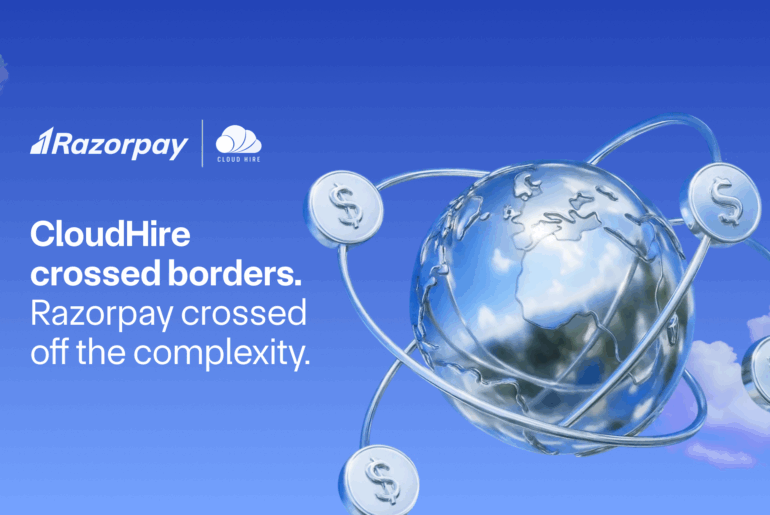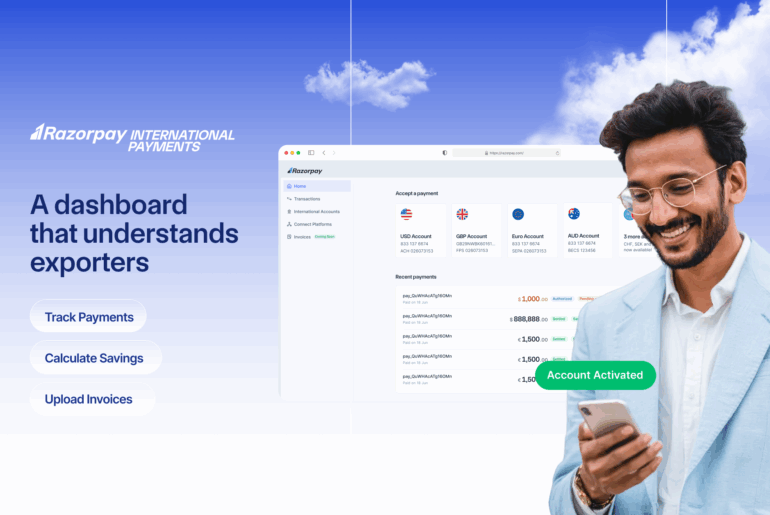Table of Contents
Understanding B2B Payments
Business-to-Business (B2B) payments are transactions between two businesses for goods or services. They help you run operations smoothly by saving time, reducing errors, and managing cash flow better. This also strengthens your relationships with vendors, suppliers, and partners.
Types of B2B Payments
1. Credit Cards
Credit cards offer a convenient way to manage B2B payments, especially for short-term expenses. They help with cash flow by allowing deferred payments and providing detailed transaction records. Virtual credit cards add a layer of security, reducing fraud risks in digital transactions.
2. Wire Transfers
Wire transfers are best for high-value or urgent transactions, both domestically and internationally. They provide real-time payments with immediate fund availability, though they may involve higher fees and daily cut-off times.
3. Razorpay and Other Digital Payment Platforms
Razorpay provides a suite of digital payment solutions, including Razorpay Payment Gateway, Payment Links, and International Payments, enabling seamless B2B transactions. Other platforms, such as PayPal and Google Pay, also facilitate secure and efficient online payments, catering to diverse business needs.
4. Paper Cheques
While declining in use, paper cheques remain relevant for businesses that prioritise security and detailed audit trails. They offer traceability and do not require immediate deposit, but processing times can be slow.
5. Cash
Cash payments provide immediate settlement without transaction fees. Suitable for small, local transactions, they eliminate the risk of interest charges but can affect cash flow visibility and security.
Efficient International Supplier Payments
Managing international B2B payments comes with challenges like currency exchange fluctuations, high transaction fees, and complex regulatory compliance. To streamline cross-border transactions, consider using multi-currency accounts, which allow you to hold and pay in different currencies, reducing conversion costs. You can also use global payment platforms which support real-time payments, simplify compliance, and offer competitive exchange rates, ensuring faster and cost-effective supplier payments.
B2B Payments Market: Growth and Trends
The global B2B payments market is witnessing rapid growth, with transaction volumes estimated at around $120 trillion annually. Key factors fuelling this growth include globalisation, which has increased the demand for efficient international transactions. Additionally, digitalisation has streamlined payment processes through automation, real-time payments, and mobile payment platforms.
Key Trends Shaping B2B Payments
1. Decline of Paper Cheques
Businesses are steadily moving away from paper cheques due to their slow processing times, higher risks of fraud, and manual handling costs. Digital payment methods offer faster, more secure, and easily trackable alternatives, making them the preferred choice for modern B2B transactions.
2. Growth in Split and Deferred Payments
Split and deferred payments are gaining popularity as they offer businesses greater flexibility in managing cash flow. This trend allows companies to divide payments over time or across multiple accounts, improving budget management and reducing financial strain.
3. Automation in AR and AP
Automation in Accounts Receivable (AR) and Accounts Payable (AP) is transforming B2B payments by reducing manual errors, speeding up transaction processing, and enhancing financial accuracy. Automated systems also improve cash flow visibility and streamline reconciliation processes.
4. Mobile Payment Adoption
Mobile payment adoption is rising as businesses seek convenience and real-time transaction capabilities. Mobile apps and digital wallets enable quick, secure payments on the go, making them ideal for SMEs and remote work environments.
5. Real-Time Payment Processing
Real-time payment processing is becoming a standard expectation in B2B transactions. It enhances cash flow management, reduces payment delays, and improves supplier relationships by ensuring funds are transferred instantly, with immediate confirmation.
6. Emergence of Peer-to-Peer Payments
Peer-to-peer (P2P) payments, traditionally popular in consumer transactions, are emerging in B2B for small, quick transfers. These systems offer speed, ease of use, and minimal transaction fees, making them suitable for SMEs and freelance payments.
Benefits of Using B2B Payment Gateway Software
1. Better Cash Flow Management
Payment gateways provide real-time tracking of transactions, enabling you to monitor inflows and outflows accurately. This helps optimise cash flow, ensuring timely payments and better financial planning.
2. Streamlined Accounting
Integrated payment gateways automate invoicing, reconciliation, and reporting, reducing manual errors. This streamlines your accounting processes, making financial management more efficient and transparent.
3. Enhanced Security
B2B payment gateways use advanced encryption, fraud detection, and compliance protocols to safeguard sensitive financial data. This reduces the risk of data breaches and unauthorised transactions.
4. Save Time and Labour
Automation of payment processes minimises the need for manual intervention, saving time and reducing administrative workload. This allows your team to focus on strategic tasks, and improve overall productivity.
Steps to Accept B2B Payments
1. Cheques
- Set Up a Business Bank Account: Ensure you have an account to deposit cheques.
- Invoice Clearly: Include your business name, address, and cheque payment details on invoices.
- Endorse and Deposit: Once received, endorse the cheque and deposit it via your bank or a mobile banking app.
- Track Payments: Maintain a record for easy reconciliation.
2. Wire Transfers
- Provide Bank Details: Share your account number, SWIFT code, and bank name with clients.
- Verify Transfer Details: Double-check the information to avoid errors or delays.
- Confirm Receipt: Monitor your account for incoming payments and send confirmation to the payer.
- Reconcile Transactions: Match payments with invoices for accurate records.
3. Electronic Bank Transfers
- Enable Direct Transfers: Register with your bank for NEFT, RTGS, or IMPS services.
- Share Transfer Instructions: Provide clients with your account details and preferred payment method.
- Monitor Transactions: Check for real-time updates through online banking.
- Record Payments: Keep detailed records for accounting and audit purposes.
4. Credit Cards
- Set Up a Merchant Account: Partner with a bank or payment processor to accept credit card payments.
- Use a POS System or Payment Gateway: Choose based on whether you’re accepting payments online or offline.
- Secure Transactions: Implement fraud protection measures like encryption and tokenisation.
- Track Settlements: Regularly review statements to reconcile payments.
5. Payment Gateway
- Choose a Reliable Provider: Opt for gateways like Razorpay, PayU, or CCAvenue based on your business needs.
- Integrate with Your Website: Add payment gateway APIs for seamless transactions.
- Enable Multiple Payment Options: Allow customers to pay via UPI, credit cards, net banking, etc.
- Monitor Transactions: Use the dashboard to track, manage, and reconcile payments easily.
Processing International and Cross-Border Payments
Managing international and cross-border B2B payments requires businesses to navigate complex factors like currency conversions, fluctuating exchange rates, and regulatory compliance across different countries. Currency conversion can impact costs due to varying exchange rates and hidden fees, making it essential to use multi-currency accounts or global payment platforms that offer competitive rates.
Compliance is another critical aspect, as businesses must adhere to international financial regulations, including anti-money laundering (AML) laws, tax obligations, and KYC (Know Your Customer) requirements.
To streamline these transactions, companies rely on secure global networks like SWIFT, payment service providers, and fintech platforms that automate compliance checks and ensure secure, timely transfers. This approach reduces risks, optimises costs, and enhances efficiency in cross-border transactions.
How Different Industries Manage B2B Payments?
1. B2B Payments in SaaS
In the SaaS (Software as a Service) industry, businesses often work with recurring billing models where customers are charged monthly or annually. Managing these recurring payments manually can be time-consuming and prone to errors. That’s why SaaS companies rely on automated payment solutions, subscription billing software, and payment gateways to handle transactions smoothly.
Benefits of B2B Payments in SaaS
- Automated recurring billing: Reduces manual effort and ensures payments are collected on time without follow-ups.
- Global payment capabilities: Makes it easy to accept payments from international clients in different currencies.
- Real-time tracking: Helps businesses monitor payment status instantly, improving cash flow visibility.
2. B2B Payments in e-Commerce
E-commerce businesses deal with thousands of transactions daily, involving suppliers, vendors, logistics partners, and marketplaces. Managing such high volumes of payments manually would lead to delays and errors. That’s why they prefer automated payment gateways, split payment solutions, and digital wallets.
Benefits of B2B Payments in e-Commerce
- Faster settlements: Ensures suppliers and vendors receive payments on time, reducing dependency on manual processes.
- Multi-currency support: Enables seamless cross-border transactions, making it easy to work with global partners.
- Automated reconciliation: Reduces accounting errors by matching payments with invoices automatically.
3. B2B Payments in AdTech
AdTech companies manage complex payment workflows involving advertisers, publishers, and media agencies. These transactions often include revenue sharing, commissions, and micropayments. Manual handling can lead to delays, discrepancies, and compliance issues.
To simplify this, AdTech firms use automated payout platforms that handle bulk transactions, calculate commissions accurately, and manage multi-party payments efficiently.
Benefits of B2B Payments in AdTech
- Automated revenue sharing: Distributes payments accurately based on predefined revenue models.
- Transparent reporting: Provides clear insights into payment status, helping businesses track and audit transactions easily.
- Global payment flexibility: Supports multiple payment methods to cater to international publishers and advertisers.
4. B2B Payments in Online Marketplaces (Gig Economy)
In online marketplaces and the gig economy, businesses handle frequent payments to freelancers, service providers, and contractors. Speed and flexibility are critical here, as gig workers expect quick payouts. Traditional banking methods may not be efficient for such fast-paced environments.
These platforms use peer-to-peer (P2P) payment systems, real-time payment solutions, and digital wallets to process payments instantly.
Benefits of B2B Payments in Online Marketplaces
- Instant payouts: Enables quick transfers, keeping freelancers and gig workers satisfied.
- Cross-border payment support: Facilitates payments to global service providers with minimal delays.
- Cost efficiency: Reduces transaction costs, especially for small, frequent payments.
5. B2B Payments in Retail
Retail businesses need to manage payments to suppliers, distributors, logistics companies, and wholesalers. Delays in payments can disrupt the supply chain, affecting inventory and sales. To avoid this, retailers use a mix of electronic fund transfers (EFT), credit facilities, and payment gateways.
Benefits of B2B Payments in Retail
- Improved cash flow management: Allows businesses to plan budgets better with predictable payment schedules.
- Automated invoicing and payments: Reduces manual work, minimising the chances of errors or missed payments.
- Stronger supplier relationships: Ensures timely payments, which helps build trust and long-term partnerships.
6. B2B Payments in Affiliate and Influencer Networks
Affiliate marketing and influencer networks rely on performance-based payments, where payouts are made based on metrics like clicks, sales, or engagement. Managing such payments manually can be complex, especially when dealing with global affiliates and influencers.
These networks use automated payment platforms that calculate commissions, handle bulk payments, and support multi-currency transactions.
Benefits of B2B Payments in Affiliate and Influencer Networks
- Automated commission payouts: Saves time by calculating and disbursing payments without manual intervention.
- Global reach: Simplifies cross-border payments, making it easy to collaborate with international affiliates.
- Real-time performance tracking: Links payments to real-time data, ensuring transparency and accountability.
Risk Management for Digital B2B Payments
Effective risk management involves identifying vulnerabilities and implementing strategies to secure transactions. This includes strengthening cybersecurity measures, ensuring compliance with regulatory standards, and regularly monitoring payment activities. Proactive risk management not only protects financial data but also maintains business integrity and trust.
Business Email Compromise (BEC)
Business Email Compromise happens when fraudsters trick businesses by pretending to be trusted suppliers or partners through email. They often hack real email accounts to send fake payment requests, making it hard to spot the fraud. To stay safe, always double-check the sender’s email address, be cautious of links and urgent requests, and call the supplier directly if something feels off. Training your team to recognise suspicious emails and using tools that detect fake accounts can help prevent such scams.
Frequently Asked Questions (FAQs)
1. What are split payments in B2B transactions?
Split payments allow a single transaction to be divided into multiple payments, either across different accounts or payment methods. This helps businesses manage cash flow and allocate expenses more efficiently.
2. What role does automation play in B2B payments?
Automation streamlines payment processes by reducing manual work, minimising errors, and ensuring timely transactions. It also improves accuracy in tracking payments and enhances overall efficiency.
3. Can B2B payments be integrated with accounting software?
Yes, B2B pay can be integrated with accounting software to automate record-keeping, simplify reconciliation, and provide real-time financial insights for better decision-making.
4. Why are paper checks still used in B2B payments?
Paper checks are still used because they provide a clear audit trail, are easy to track, and are preferred by some businesses for security and traditional accounting practices.
5. What are the benefits of using a payment gateway for B2B transactions?
A payment gateway offers secure, fast, and reliable payment processing. It supports multiple payment methods, reduces fraud risks, and simplifies cross-border transactions.
6. How can I ensure the security of my B2B payments?
You can secure B2B payments by using strong authentication methods, verifying payment details, monitoring transactions regularly, and educating employees to detect phishing or fraud attempts.
7. Can B2B payments be processed through mobile apps?
Yes, B2B payments can be processed through mobile apps, offering convenience, real-time tracking, and secure transactions, especially for businesses managing payments on the go.


